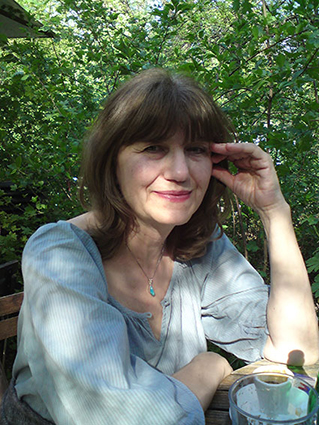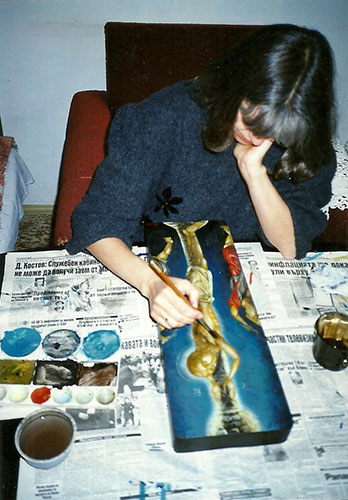
When I was a child I knew that I was born to be an artist.
At the age of thirteen I started to visit private lessons in drawing and painting in order to apply for the National Academy of Fine Arts six years later.
But it happened that the direction of my life unexpectedly had been turned aside and I became a mining engineer (MA, Mining and Geology University, Sofia, 1978). Despite the practising this profession for twelve years, I had never abandoned my idea of becoming an artist and in 1989 (the year of the democratic changes in my country Bulgaria) I decided to quit my job and to dedicate the rest of my life to my first and strongest desire. I was 35.
It was a good chance that immediately after leaving my job, friends of mine allowed me to help in their restoration studio. There I had the opportunity to closely observe and touch Bulgarian icons from 18th and 19th century, painted by unknown iconographers.
The purity of the feeling radiating from these icons, inspired me to start studying the Bible and later the philosophy of the Byzantine pictorial system. My interest in this matter led me to my theological education (MA, Sofia University “St Kliment Ohridski” - Theology Faculty, 2000).
When I left the restoration studio two years later, I was already mastering the technique of icon-painting on wooden panel, which gave me the possibility to continue my work as an independent artist.
I started to develop a kind of symbolic art, in which I was supported by my knowledge of the Byzantine pictorial heritage, on the one hand, and my emotional attraction to the Bible text, on the other.
Unveiling the message of the Biblical events was an extraordinary emotional process for me.
Every grabbed handful of this treasure I was turning into an image. When I was painting the healing of the man born blind, I also began to see; I came back to life together with the resurrected Lazarus; I took my place in the queue behind the Christ's disciples waiting for Christ to wash my feet too.
In this way, little by little, creating images, I was also touched by the healing hands of Christ. The intellectual and the emotional parts of my personality had been joined and I obtained the necessary spiritual firmness to turn my attention to the Old Testament – conflicting and even brutal in its truthfulness writing, where the human nature is revealed in its entire power and beauty.

Such an emotional examination of the Bible led me to the inventing of a new iconography of the Biblical events. I continue to work in this direction. Meanwhile I developed a special lacquer technique, based on the traditional Byzantine iconographical technique on a wooden panel.
My works have been exposed in more than forty individual exhibitions till now, in Bulgaria (Sofia, Vidin, Pleven, Plovdiv), Macedonia (Struga, Bitola), Greece (Thassos, Drama), North Holland (Egmond Binnen, Den Haag, Amsterdam, Leeuwarden, Drachten, Warmenhuizen, Castricum, Audkarspel), Norway (Svalbard), France (Grenoble, Vienne), Italy (Venice), UK (London), Germany (Freiburg).
In 2016 I published my book “Watercolour bible”, where are collected my works inspired by the first chapters of Genesis. Here I represent my interpretation of the Creation of world and Man. The illustrations are my previous compositions on this matter rehashed in watercolour drawings.
Now I am working on a series of works based on the Gospel according St. Mark.
I am concentrated especially on the miraculous healing gestures of Christ. The newborn images, painted on wooden panels, will be gathered in my next book.
…
My book was published in the spring this year (2018) under the title “Gentle Touch among the Crowd (Talks with Mark)”. Here is the introduction of the book:
“Seven years ago I was invited by the French artists Elisabeth Lamour, Betsie Pequignot and Anne Brugirard to take part in an exhibition dedicated to the miraculous cures in the gospel of Mark. We arranged it in the oldest cathedral in Vienne – a charming town situated on the river Rhone. This town, with its early Christian stone churches and Roman ruins, was the perfect place for such an exhibition.
Especially for this event I created several new compositions, but after the exhibition I remained very much attracted by the gospel of Mark and I continued my work on this subject. In this way, reading and thinking on the text of Mark, I created my latest cycle of paintings. The title of the cycle - “Gentle Touch among the Crowd” - refers to the cure of the sick woman with the flow of blood.
What I like very much in this gospel is its brevity and modesty at the same time. Mark omits the Annunciation, the genealogy of Christ, the miraculous conception of John the Baptist etc., but at the expense of this he emphasizesthe cures performed by Christ. That is why the text “sounds” rather humanly than divinely. And one of the most significant cures-the healing of a deaf and dumb man-could be found only in the gospel of Mark.
In the miraculous cures described by Mark I see a manifestation of the boundless love and mercy of Jesus Christ to every person who is dropped out of the society because of illness or infirmity.
Through the healing Jesus Christ gives us back the lost gifts of God and we are able, in every sense, to go up to the place, which God had been prepared for the human being primordially. In other words, we-the cured people-are lost sheep found by our shepherd ONE BY ONE. That is why the gospel of Mark touches directly our hearts and we remain with the warming feeling that, whatever happens, Somebody cares about us.”
The cycle of paintings dedicated to the Gospel of Mark, was exhibited in May 2018 in Sofia (Paris gallery) and in November 2018 in Athens (Divani Caravel hotel).
I believe the cycle of paintings “Gentle touch among the crowd” will have the chance to be exhibited at more places in the future.
***
I am currently (2018-2019) working on my new artistic project - "The Gospel Woman”.
I have always been fascinated by the female presence in the Gospel narrative.
In the order of thought shared at the beginning of my website, I would add the notion of the "gospel woman" to the lost Biblical notions that is good to be “resurrected”.
Although the gospel woman is rarely in the forefront, if we take a closer look at the evangelical text, we will find that her presence is given a special attention.
The Biblical writer just gives the facts and leaves for us the artistic interpretations.
As if the Biblical facts are just the framework, in which we could weave the portrait of the gospel woman.
In other words, the Biblical facts inspire us to “paint” a portrait of her beautiful soul, extremely blossoming into the graceful closeness of Jesus Christ.
The gospel woman does not seek for a better place in the Kingdom of God, she does not demonstrate her presence, she is not engaged in arguments.
It is enough for her to follow her Lord, to be always close to Him and to serve Him.
She is a quiet witness to all His sermons and grasps the message, hidden in His symbolical language, directly, without any further explanations.
The secret of her vigorous spiritual rush is hidden in the way she listens to the words of Christ.
She perceives them not so much with her intellect as through her delicate and intelligent heart.
Every woman awarded with the sight of Christ, converts herself into a gospel woman.
Christ's eyes penetrate into her heart of hearts and find a hidden treasure there, which would remain invisible for the others, and even for herself, if it was left unseen.
In the light of Christ’s sight, the woman rediscovers herself as she was initially created, and got the power to step across from sin to holiness.
(written by Julia Stankova in December, 2018)
 When I was a child I knew that I was born to be an artist.
When I was a child I knew that I was born to be an artist. Such an emotional examination of the Bible led me to the inventing of a new iconography of the Biblical events. I continue to work in this direction. Meanwhile I developed a special lacquer technique, based on the traditional Byzantine iconographical technique on a wooden panel.
Such an emotional examination of the Bible led me to the inventing of a new iconography of the Biblical events. I continue to work in this direction. Meanwhile I developed a special lacquer technique, based on the traditional Byzantine iconographical technique on a wooden panel.